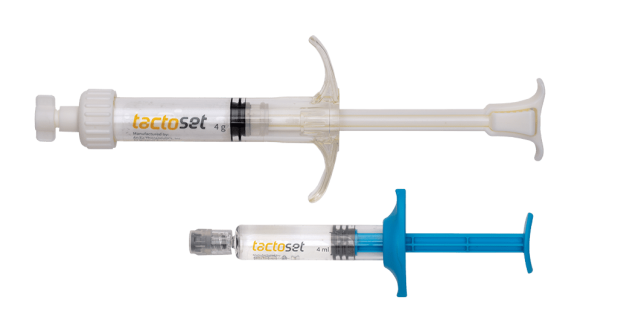Injectable bone substitutes can play an important role in some orthopedic procedures. For patients who require surgery to repair joint problems such as rotator cuff tears and knee reconstruction, these products reinforce bone strength, giving surgeons secure locations for anchoring hardware, ultimately leading to better patient outcomes such as a return to their active lifestyles. The U.S. Food and Drug Administration (FDA) recently cleared Tactoset® Injectable Bone Substitute for this purpose.
Hardware like suture anchors are used by orthopedic surgeons to reattach soft tissue – such as torn tendons and ligaments – to bone. Because the bone that the hardware attaches to is often poor quality, especially as people age, Tactoset can now be used to improve the strength of the anchor placement and increase confidence in the final repair. Tactoset has been shown to increase the “pullout” strength of a screw-in suture anchor two-fold1 compared to a suture anchor alone. It allows for the placement of anchors in the optimal location, eliminating the need for additional anchors or more complex repair techniques.
“Bone quality is a critical factor when placing load-bearing anchors, and the area in which hardware is normally placed is often weaker due to inferior bone quality or insufficiency [stress] fractures,” said Misty Suri, MD, an orthopedic surgeon with Ochsner Health in New Orleans. “Shoulders, knees and other joints that require surgery are often associated with either osteoporotic bone and/or lower quality bone, which significantly increases the potential for pain, hardware failure, and inferior patient outcomes. With this new, approved use of Tactoset, we are able to address the concern for microfractures and bone quality while creating a strong foundation to augment the use of suture anchors and other hardware. This gives surgeons more confidence in repairs such as rotator cuff, shoulder instability, and knee reconstructive surgeries.”
Since coming to market in 2019, Tactoset has been used to treat stress fractures, bone voids (cavities in the bone caused by trauma or cysts), and other skeletal defects, akin to how a dentist fills a cavity. Tactoset is enhanced by hyaluronic acid (HA), a naturally occurring lubricant that helps make Tactoset easy for surgeons to work with by increasing its injectability and flowability. Once injected, Tactoset hardens and mimics the properties of certain types of bones, then remodels into healthy bone over time.
Joint surgery products and techniques are constantly evolving. Talk to your surgeon about the latest ones.
Would you like to locate a physician in your area familiar with Tactoset and other surgical innovations? Try our Find the Doctor Tool or Contact Us for more information.




